Disposable EEG Electrode Market Research, 2031
The global disposable EEG electrode market size was valued at $386.3 million in 2021, and is projected to reach $542.2 million by 2031, growing at a CAGR of 3.5% from 2022 to 2031. Electroencephalography (EEG) is a device that detects electrical activity in the brain. Disposable EEG electrodes are used in the examination of EEG. Disposable EEG electrodes are designed to provide accurate reading of electrical impulses in the brain. Moreover, disposable EEG electrode reduces the possibility of cross-contamination and save time when compared to reusable EEG electrode. Disposable EEG electrodes are preferred over reusable EEG electrode in COVID-19 due to increased hygienic practices. Disposable EEG electrodes includes grass disposable deep-cup EEG electrode, Cadwell disposable EEG+ cup electrode and rythmlik disposable cup electrode.
Historical overview
The disposable EEG electrode market size was analyzed qualitatively and quantitatively from 2021 to 2031. The Disposable EEG electrode market grew at a CAGR of around 3.5% during 2022-2031. Most of the growth during this period was derived from North America owing to rise in the number of disposable EEG electrode industry that manufacture cup electrode, rise in disposable incomes as well as well-established presence of domestic companies in the region.
Market Dynamics
Growth of the global disposable EEG electrode market share is majorly driven by increase in the prevalence of neurological and brain disorders, rise in the number of geriatric populations, rise in the prevalence of hospital acquired infection. Increase in prevalence of neurological disorders such as Parkinson’s disease, epilepsy, essential tremor, and dystonia are anticipated to fuel the demand for disposable EEG electrode. Parkinson disease (PD) is a degenerative condition of the brain associated with motor symptoms (slow movement, tremor, rigidity and imbalance) and other complications including cognitive impairment, mental health disorders, sleep disorders and pain and sensory disturbances. Disposable EEG electrode are used for diagnosis of Parkinson’s disease and epilepsy. EEG is a noninvasive and affordable way to detect neurological diseases such as Parkinson's disease. Thus, rise in prevalence of Parkinson's disease and epilepsy are anticipated to drive the disposable EEG electrode market growth.
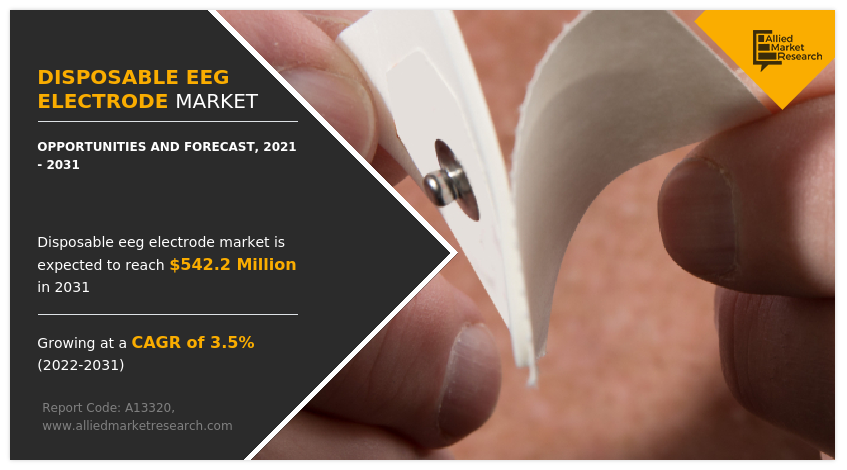
For instance, according to World Health Organization (WHO) it was reported that, in 2019, Parkinson’s disease resulted in 5.8 million individuals, an increase of 81% since 2000, and caused 329 000 deaths, an increase of over 100% since 2000. In addition, according to World Health Organization (WHO), in February 2022, it was reported that approximately 50 million population is suffering from epilepsy across the globe. Thus, rise in incidence of neurological disorders are anticipated to drive the growth of market.
In addition, rise in the prevalence of brain disorders such as brain tumor is anticipated to fuel the demand of EEG electrode for diagnosis purpose. For instance, according to American Cancer Society, in 2022, it was reported that, the number of population suffering from brain tumor is 25,050 in the U.S.
Geriatric population is majorly susceptible to suffer from neurological diseases and brain disorder such as Parkinson’s disease and brain tumor. Age is the largest risk factor for the development and progression of Parkinson's disease (PD). Ageing affects many cellular processes that predispose to neurodegeneration, and age-related changes in cellular function predispose to the pathogenesis of PD. Thus, rise in number of geriatric population cause increase in prevalence of Parkinson's disease. Thus, this factor is anticipated to drive the market growth. For instance, according to the U.S. Census Bureau data published in December 2021, more than 56 million adults ages 65 i.e., 16.9% of the nation’s population and by 2050 is estimated to rise 85.7 million. Moreover, according to report shared by World health Organization (WHO), it was reported that, population aged 60 years and over will increase from 1 billion in 2020 to 1.4 billion over the globe. As per the same report, it was estimated that, by 2050, the world’s population of people aged 60 years and older will double (2.1 billion).
Infections that patients contract while seeking treatment at a healthcare institution, such as a hospital, or from a healthcare practitioner, such as a doctor or nurse, are known as healthcare-acquired illnesses (HAIs), also known as healthcare-associated infections. Healthcare-Acquired Infections can affect the digestive system, lungs, skin, urinary tract, and scalp. Reusable EEG electrode can transmit infection. Disposable EEG electrode are used to avoid cross contamination. Rise in the usage of disposable EEG electrode by hospitals, clinics, diagnostic centers and clinical laboratories to avoid hospital acquired infection is anticipated to boost the growth of market.
Increase in initiatives taken by government and rise in expenditure by government to develop healthcare infrastructure is anticipated to drive the growth of disposable EEG electrode market. The World Health Assembly approved the Intersectoral Global Action Plan on Epilepsy and Other Neurological Disorders 2022-2031 in May 2022. The action plan will address the challenges and gaps in providing care and services for people with epilepsy and other neurological disorders like Parkinson's disease that exist globally in order to provide a full, coordinated response across sectors. This entails enhancing governance, establishing higher policy priorities, providing rapid, accurate, and responsive diagnosis, treatment, and care, implementing promotion and prevention strategies, supporting research and innovation, and enhancing information systems. In addition, as per the Office for National Statistics, total healthcare expenditure in the UK accounted for 12.0% of the gross domestic product (GDP) in 2020, as compared to 9.9% in 2019. Furthermore, it has been estimated that 30% of the healthcare expenditure is used in upgrading the healthcare infrastructure, especially medical equipment and application used at public health centers, such as hospitals. Hence, rise in healthcare expenditure across the globe is expected to fuel the demand for disposable EEG electrode application in neurological and brain disorders for diagnosis and treatment, thereby boosting the market growth.
On the other hand, the growth of the disposable EEG electrode market is anticipated to be constrained by the rising use of alternatives, such as reusable EEG medical electrodes. For instance, EEG reusable medical electrodes provide advantages including being less expensive, more robust, flexible, and lightweight. Genuine Grass Reusable Cup EEG Electrodes are available from Natus Medical Incorporated. These electrodes have undergone thorough mechanical and electrical testing to ensure long life for very high recording clarity and dependability. Both steam and EtO sterilization are suitable with these reusable electrodes. These electrodes' cups are made of gold or silver to lower the risk of contamination and cross-contamination.
Segmental Overview
The disposable EEG electrode market share is segmented into shape, application and end user, and region. By shape, the market is segmented into cup electrode, needle electrode and disk electrode. By application, the market is segmented into diagnostic and therapeutic. By end user, the market is segmented into hospital and clinics, diagnostic centers, ambulatory surgical centers, and others. Region-wise, the market is analyzed across North America, Europe, Asia-Pacific, and LAMEA.
By Shape: Based on shape, the market is segmented into cup electrode, needle electrode and disk electrode. The cup electrode segment dominated the market in 2021 and is expected to continue this trend during the disposable EEG electrode market forecast period, owing to rise in number of product launch and products approvals for cup electrode and increase in number of companies that manufacture disposable EEG electrode.
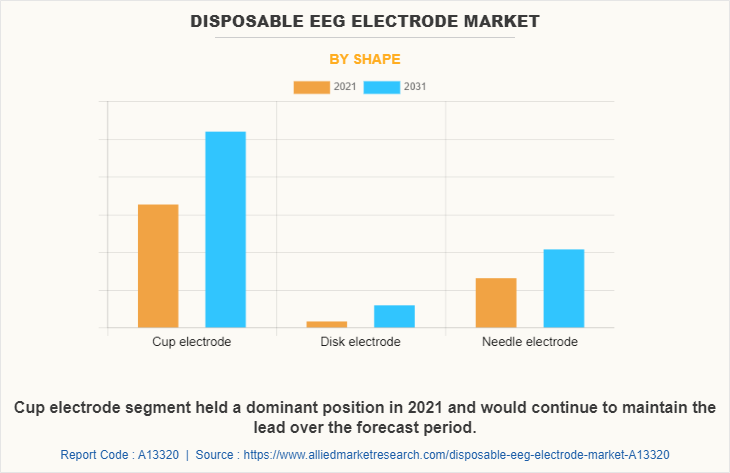
By Application: Based on application, the market is bifurcated into diagnostic and therapeutic. The diagnostic segment dominated the market in 2021 and is expected to continue this trend during the forecast period, owing to increase in the prevalence of neurological disorders and brain diseases.
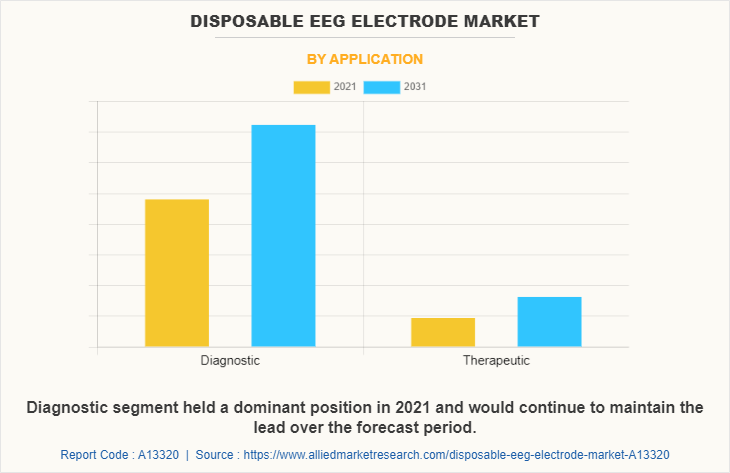
By end user: Based on end user, the market is divided into hospital and clinics, diagnostic centers, ambulatory surgical centers, and others. The hospitals and clinics segment dominated the market in 2021 and is expected to continue this trend during the forecast period, owing to rise in expenditure by government to develop healthcare infrastructure and increase in number of hospitals and clinics.
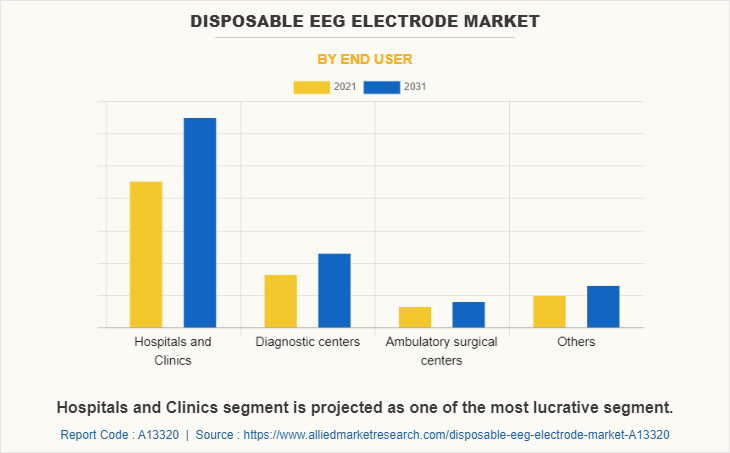
North America disposable EEG electrode market is expected grow during the forecast period owing to increase in the incidence of Parkinson’s disease, epilepsy and other neurological disorders, increase in number of disposable EEG electrode industry and rise in the prevalence of brain tumor. For instance, according to American Cancer Society, in 2022, estimated number of populations is suffering from brain tumor is 25,050 in the U.S. In addition, rise in the prevalence of Parkinson’s disease increases the demand for disposable EEG electrode. Thus, this factor is anticipated to drive the growth of market.
Moreover, rise in expenditure by government to develop healthcare infrastructure and increase in awareness among people regarding hospital acquired infection is anticipated to fuel the market growth. For instance, according to the Centers for Medicare & Medicaid Services, the U.S. health care spending grew by 9.7% from 2019 to 2020, reaching $4.1 trillion ($12,530 per person).
Asia-Pacific disposable EEG electrode market is expected to grow in the forecast period owing to rise in number of populations suffering from neurological disorders, increase in the awareness among population and healthcare providers regarding hospital acquired infection. For instance, in April 2021, according to article shared by Health Care Radius, it was reported that, approximately 7 million people in India are suffering from Parkinson’s disease (PD). The incidence and prevalence of PD increase with advancing age (mostly 65 and above). Most commonly, this condition exhibits itself after the age of 50 years, but in some rare cases, it can affect people of younger age group as well. Thus, this factor fuels the demand of disposable EEG electrode and drives the market growth.
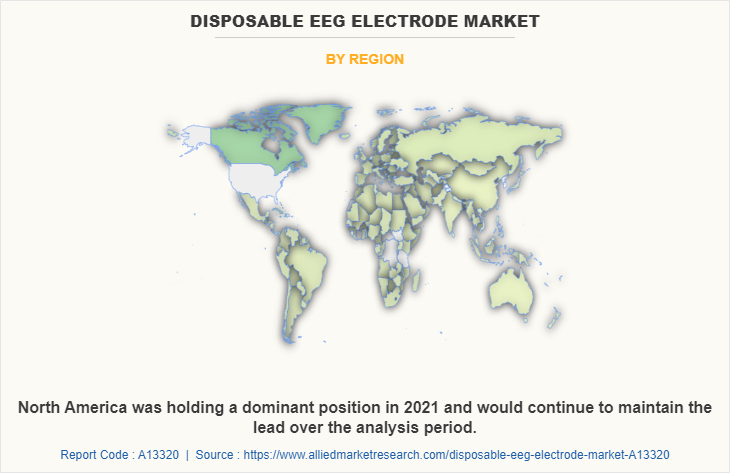
Moreover, the increase in geriatric population of Asia-Pacific is one of the propelling factors that drive growth of the market. Geriatric population is more susceptible to neurological disorders. Thus, this factor is anticipated to drive the growth of market. According to the 2020 census, there are approximately 264 million (18.70%) people in China in the application of 60 and over. Moreover, key players in this region focus on expanding their business, which is expected to significantly enhance revenue generation, owing to availability of untapped areas and low cost of services.
COMPETITION ANALYSIS
Some of the major companies that operate in the disposable EEG electrode market include Medtronic PLC, Ambu A/S, CONMED Corporation, Brain Scientific, Inc, Natus Medical Incorporated, Rhythmlink International, LLC, Cadwell Industries, Inc, Philips Disposable EEG Snap, Nihon Kohden Disposable Gold Cup EEG Electrode, GE healthcare Disposable EEG Cup Electrodes.
Some examples of product launch in the market
In April 2020, Brain Scientific Inc. medical equipment manufacturing company, announced the launch of an online store to sell sanitized Food and Drug Administration (FDA)-cleared NeuroCap and NeuroEEG. This may increase the customer pool of the company. Key players are also investing heavily in research and development to manufacture technologically advanced products.
Key Benefits For Stakeholders
- This report provides a quantitative analysis of the market segments, current trends, estimations, and dynamics of the disposable eeg electrode market analysis from 2021 to 2031 to identify the prevailing disposable EEG electrode market opportunity.
- The market research is offered along with information related to key drivers, restraints, and opportunities.
- Porter's five forces analysis highlights the potency of buyers and suppliers to enable stakeholders make profit-oriented business decisions and strengthen their supplier-buyer network.
- In-depth analysis of the disposable eeg electrode market segmentation assists to determine the prevailing market opportunities.
- Major countries in each region are mapped according to their revenue contribution to the global market.
- Market player positioning facilitates benchmarking and provides a clear understanding of the present position of the market players.
- The report includes the analysis of the regional as well as global disposable eeg electrode market trends, key players, market segments, application areas, and market growth strategies.
Disposable EEG Electrode Market Report Highlights
| Aspects | Details |
| Market Size By 2031 | USD 542.2 million |
| Growth Rate | CAGR of 3.5% |
| Forecast period | 2021 - 2031 |
| Report Pages | 387 |
| By Shape |
|
| By Application |
|
| By End User |
|
| By Region |
|
| Key Market Players | Cadwell Industries, Inc, Natus Medical Incorporated, Koninklijke Philips N.V., General Electric Company, Brain Scientific, Inc, Ambu A/S, Nihon Kohden Corporation, Rhythmlink International, LLC, CONMED Corporation, Medtronic plc |
Analyst Review
Disposable electroencephalogram (EEG) electrode are devices used by healthcare professional to measure brainwaves. EEG electrodes are usually made from silicone material, which makes them lightweight and flexible. They are also easy to attach to the head and can be removed without damaging the scalp.
Increase in the number of product launches and product approvals for disposable EEG electrode and rise in the number of adoption of strategies such as collaboration, acquisition, and partnership by market players drive the market growth. For instance, in April 2020, Brain Scientific Inc. medical equipment manufacturing company, announced the launch of an online store to sell sanitized Food and Drug Administration (FDA)-cleared NeuroCap and NeuroEEG. This may increase the customer pool of the company. Key players are also investing heavily in research and development to manufacture technologically advanced products.
The top companies that hold the market share in disposable EEG electrode market are Medtronic PLC, Ambu A/S, CONMED Corporation, Brain Scientific, Inc, Natus Medical Incorporated, Rhythmlink International, LLC, Cadwell Industries, Inc, Philips Disposable EEG Snap, Nihon Kohden Disposable Gold Cup EEG Electrode, GE healthcare Disposable EEG Cup Electrodes.
Asia-Pacific is expected to register highest CAGR from 2022 to 2031, owing to rise in expenditure by government organization to develop the healthcare sector and increase in awareness regarding cross contamination in hospital.
The key trends in the disposable EEG electrode market include technological advancement for development of different disposable EEG electrode, rise in the number of neurological diseases and various strategies adopted such as product launch and product approval by the market key players
The base year for the report is 2021.
Yes, disposable EEG electrode market companies are profiled in the report
The total market value of disposable EEG electrode market is $386.3 million in 2021.
The forecast period in the report is from 2022 to 2031
The market value of disposable EEG electrode market in 2022 was $399.1 million
Loading Table Of Content...



